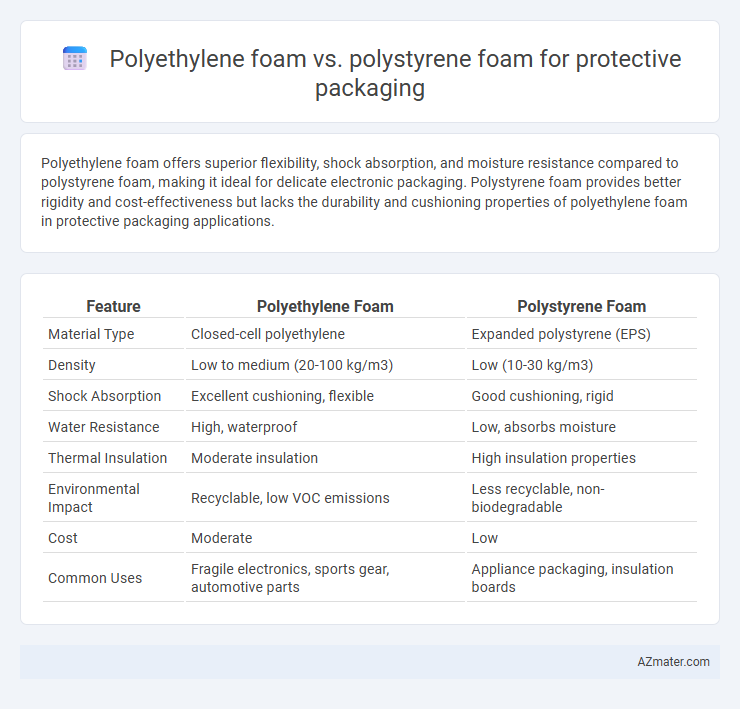Polyethylene foam offers superior flexibility, shock absorption, and moisture resistance compared to polystyrene foam, making it ideal for delicate electronic packaging. Polystyrene foam provides better rigidity and cost-effectiveness but lacks the durability and cushioning properties of polyethylene foam in protective packaging applications.
Table of Comparison
| Feature | Polyethylene Foam | Polystyrene Foam |
|---|---|---|
| Material Type | Closed-cell polyethylene | Expanded polystyrene (EPS) |
| Density | Low to medium (20-100 kg/m3) | Low (10-30 kg/m3) |
| Shock Absorption | Excellent cushioning, flexible | Good cushioning, rigid |
| Water Resistance | High, waterproof | Low, absorbs moisture |
| Thermal Insulation | Moderate insulation | High insulation properties |
| Environmental Impact | Recyclable, low VOC emissions | Less recyclable, non-biodegradable |
| Cost | Moderate | Low |
| Common Uses | Fragile electronics, sports gear, automotive parts | Appliance packaging, insulation boards |
Introduction to Protective Packaging Foams
Polyethylene foam and polystyrene foam are widely used materials in protective packaging due to their cushioning properties and impact resistance. Polyethylene foam offers excellent flexibility, high resilience, and moisture resistance, making it ideal for packaging delicate electronics and sensitive equipment. Polystyrene foam, valued for its rigid structure and superior shock absorption, is commonly used for insulation and packaging fragile items like glassware and ceramics.
Understanding Polyethylene Foam
Polyethylene foam is a lightweight, closed-cell material known for its excellent cushioning properties and high water resistance, making it ideal for protective packaging. Its flexibility and shock absorption capabilities outperform polystyrene foam, which tends to be rigid and brittle, especially under impact. Polyethylene foam's chemical inertness and recyclability also contribute to its growing preference in sustainable packaging solutions.
Exploring Polystyrene Foam
Polystyrene foam offers excellent rigidity and impact resistance, making it ideal for protective packaging of fragile or heavy items. Its lightweight structure combined with high compressive strength provides superior shock absorption compared to polyethylene foam. Unlike polyethylene foam, polystyrene foam resists moisture and chemical exposure better, enhancing its durability in diverse shipping environments.
Key Differences Between Polyethylene and Polystyrene Foams
Polyethylene foam offers superior flexibility, impact absorption, and water resistance compared to the rigid, brittle nature of polystyrene foam, making it ideal for cushioning fragile items. Polystyrene foam is lightweight and provides excellent thermal insulation but lacks durability and is prone to cracking under stress. The choice between polyethylene and polystyrene foams in protective packaging depends on application-specific requirements such as shock absorption, moisture resistance, and environmental sustainability.
Impact Resistance and Cushioning Performance
Polyethylene foam offers superior impact resistance and cushioning performance compared to polystyrene foam, thanks to its closed-cell structure that absorbs shocks more effectively. Polystyrene foam, while lightweight and rigid, tends to crack under high stress, making it less reliable for protecting fragile items during transit. The elasticity and resilience of polyethylene foam reduce the risk of damage by providing better energy absorption and sustained cushioning in protective packaging applications.
Weight and Cost Comparison
Polyethylene foam is significantly lighter than polystyrene foam, making it ideal for reducing shipping weight and associated costs in protective packaging. Regarding cost, polystyrene foam is generally more affordable, offering a budget-friendly option for bulk packaging needs despite its higher density. Optimizing packaging choices between weight and cost depends on balancing polyethylene's lightweight and durability with polystyrene's economic advantage.
Environmental Impact and Sustainability
Polyethylene foam offers superior environmental benefits compared to polystyrene foam due to its recyclability and lower carbon footprint in production. Polystyrene foam, while lightweight and effective in shock absorption, is less biodegradable and often ends up in landfills, contributing to long-term pollution. Choosing polyethylene foam enhances sustainability by supporting circular economy practices and reducing ecological harm associated with protective packaging materials.
Applications in Protective Packaging
Polyethylene foam excels in protective packaging due to its flexibility, resilience, and excellent shock absorption, making it ideal for cushioning fragile electronics, medical devices, and delicate instruments. Polystyrene foam is frequently used for rigid packaging solutions, offering superior insulation and structural support suited for packaging heavy or temperature-sensitive products like appliances and food containers. Both materials provide effective protection, but polyethylene foam is preferred for impact resistance and reusable packaging, while polystyrene is favored for lightweight, cost-effective, single-use applications.
Choosing the Right Foam for Your Packaging Needs
Polyethylene foam offers superior flexibility, impact resistance, and moisture resistance, making it ideal for cushioning delicate electronics and fragile items during shipping. Polystyrene foam provides excellent rigidity and compressive strength, suitable for protecting heavier or more structurally vulnerable products. Selecting the right foam depends on product sensitivity, weight, and exposure conditions to ensure optimal protection and cost-efficiency.
Conclusion: Polyethylene vs Polystyrene in Protective Packaging
Polyethylene foam offers superior flexibility, resilience, and moisture resistance compared to polystyrene foam in protective packaging applications. Its ability to absorb shocks and vibrations makes it ideal for fragile items, while polystyrene, though lightweight and cost-effective, lacks the same durability and cushioning properties. Choosing polyethylene foam ensures enhanced product protection and longer-lasting packaging performance.

Infographic: Polyethylene foam vs Polystyrene foam for Protective packaging
 azmater.com
azmater.com